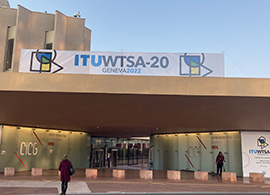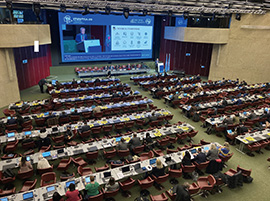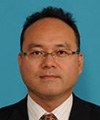 |
|
|
|
|
|
Global Standardization Activities Vol. 20, No. 8, pp. 72–77, Aug. 2022. https://doi.org/10.53829/ntr202208gls Report on WTSA-20 (World Telecommunication Standardization Assembly)AbstractDue to the impact of COVID-19, the World Telecommunication Standardization Assembly (WTSA-20), which was scheduled to be held in 2020, was held locally and online in Geneva, Switzerland, from March 1 to 9, 2022. This article provides an overview of WTSA-20 and the main deliberations. Keywords: WTSA, ITU-T, Study Group 1. Position of WTSAThe World Telecommunication Standardization Assembly (WTSA) is a general assembly of the International Telecommunication Union - Telecommunication Standardization Sector (ITU-T), which meets once every four years. The Plenipotentiary Conference makes decisions for the ITU as a whole, as shown in Fig. 1. As shown in Fig. 2, there are five committees (COM1–5) under the Plenary session (PL), which is responsible for decision-making as the General Assembly. Under COM3 and COM4, there are two working groups (WG3A, WG3B, WG4A, and WG4B) for detailed discussions. Since each committee has limited time for deliberations, ad-hoc meetings are held as needed for additional discussions, and drafting meetings are held as needed to revise resolutions. In WTSA-20, chairs and vice-chairs were elected, as shown in Fig. 2, and the PL vice-chair and COM2 vice-chair were elected from Japan.
In addition to deliberating on resolutions that establish guidelines such as ITU-T activities and working methods, WTSA deliberates on the reorganization of Study Groups (SGs) and elects chairs and vice-chairs of the Telecommunication Standardization Advisory Group (TSAG) and WTSA’s committees. Many discussions at WTSA are related to policy issues and the management policies of the organization, unlike SG meetings. Therefore, a large number of government officials participate in WTSA. The participation of the private sector also plays an important role, as individual deliberations include technical content. WTSA has six regions: Asia-Pacific Telecommunity (APT), European Conference of Postal and Telecommunications Administrations (CEPT), Inter-American Telecommunications Commission (CITEL), African Telecommunications Union (ATU), Council of Arab Ministers of Telecommunication and Information represented by the Secretariat-General of the League of Arab States (LAS), and Regional Commonwealth in the field of Communications (RCC). 2. Impact of COVID-19 on WTSA-20WTSA-20 was originally scheduled to be held in Hyderabad, India, but was repeatedly postponed due to the global pandemic (COVID-19) starting in early 2020, and was finally held as a hybrid local and online meeting in Geneva, Switzerland. In March 2022, the effects of the global pandemic had not subsided, and many companies placed travel restrictions on participants, forcing many to abandon their on-site participation. The conference was held under unusual circumstances, as travelers were required to be vaccinated in advance, undergo PCR (polymerase chain reaction) testing, and wear masks at the venue (Photos 1 and 2). During deliberations, with the exception of some discussions, online participation was made possible, allowing for remote participation. The disciplined behavior of the participants allowed us to complete the deliberations of WTSA-20 without any major problems. WTSA-24 has been announced to be hosted by India.
3. SG reorganizationSG reorganization is an important deliberation item handled by WTSA. However, as WTSA-20 was postponed due to COVID-19, it was agreed to basically maintain the SG structure for the 2017–2020 study period, and its operation is already underway from 2021. There was not much discussion and the SG structure was approved in Resolution 2 (ITU Telecommunication Standardization Sector study group responsibility and mandates). In Resolution 2, it was added that SG11 and SG17 should cooperate in security-related studies, and other minor revisions were made and approved. The Question proposed by each SG was also approved. The new study period was successfully started. 4. Election of chairs and vice-chairsAlthough the appointment of chairs and vice-chairs was provided in Resolution 35, the new Resolution 208 (Appointment and maximum term of office for chairmen and vice-chairmen of the ITU) was approved at the 2018 ITU Plenipotentiary Conference (PP-18). Therefore, Resolution 35 was suppressed. PP Resolution 208 includes a provision that each SG should have no more than three vice-chairs from each region to ensure regional balance. The chairs and vice-chairs elected by WTSA-20 in accordance with PP Resolution 208 are listed in Table 1 (* in the table indicates a second term). New chairs were elected in TSAG, SG3, 5, 11, 12, 13, 15, 17, and 20. Regional balance was emphasized in the selection of chairs, with the exception of Japan (SG9 and SG13) and Korea (SG17 and SG20), which elected two chairs, and no other country elected more than two. Seven vice-chairs were elected from Japan including two from NTT.
5. Major resolutions discussed at WTSA-20WTSA-20 approved two new resolutions and suppressed four resolutions (Resolutions 35, 45, 59, and 66). Other resolutions were approved with revisions or no changes. The following is a summary of the main deliberations. 5.1 Resolutions 72/73/79In response to the progress in wireless communication services such as the 5th-generation mobile communication system (5G), and the growing concern about climate change, the committee discussed the proposed revisions to human exposure to electromagnetic fields (Resolution 72), climate change (Resolution 73), and the circular economy (Resolution 79). For Resolution 72 (Measurement and assessment concerns related to human exposure to electromagnetic fields), all regions (APT, CEPT, CITEL, ATU, LAS, RCC) proposed revisions. At COM4, the proposals from each region were compiled into a Working Document for ad-hoc discussion. The first of the proposed revisions was to rationalize the content of the description in accordance with the rationalization guidance approved at PP-18, and the second was to comply with the International Commission on Non-Ionizing Radiation Protection (ICNIRP) guidelines (revised in March 2020), which had been revised in anticipation of the use of new frequency bands in the 5G mobile network. The third was support for developing countries. The ad-hoc meeting agreed to update and delete redundant parts of the preamble and add and update the content such as promotion of ITU-T recommendations referring to the ICNIRP guidelines and support for developing countries. For Resolution 73 (Information and communication technologies, environment, and climate change), five regions other than LAS proposed revisions, which were discussed in an ad-hoc meeting. There were two main points of revision: streamlining the description and adding the circular economy to the scope. The ad-hoc meeting reflected the proposals to remove redundant parts, add the circular economy to climate-change measures, clarify the various conditions (geographical, industrial structure, etc.) and challenges faced by developing countries, and add ecosystem monitoring, which was proposed by APT. For Resolution 79 (The role of telecommunications/information and communication technologies in handling and controlling e-waste from telecommunication and information technology equipment and methods of treating it), ATU and APT submitted a proposal for revision, and an informal drafting group edited the draft. In addition to updating the description, it was agreed to add a section on regulations against counterfeiting of electronic waste and the importance of sustainable management. 5.2 New resolution on considering reorganization of SG structureAs mentioned in the previous section, it was agreed that the SG structure for the next study period will maintain the structure of the 2017–2020 study period, and that the reorganization of the SG structure in Resolution 2 will be implemented at WTSA-24. Prior to this, TSAG has been studying the analysis of evaluation indicators for the optimal allocation of the SG structure, and an action plan for the restructuring analysis was agreed upon at the TSAG meeting held in January 2022. This action plan aims for a thorough review of potential restructuring options for ITU-T based on the empirical analysis and was input by TSAG to WTSA-20 with a view to approving the proposed SG restructuring at WTSA-24. A new resolution on the consideration of ITU-T restructuring for the purpose of implementing this action plan on the analysis of the ITU-T SG restructuring prepared by TSAG and for the TSAG to provide each SG with a progress report on the restructuring analysis and submit a report with recommendations for consideration at the next WTSA-24 was proposed. The draft proposal (Consideration of organizational reform of the ITU Telecommunication Standardization Sector study group) was approved. 5.3 New resolution on pandemicsDue to the impact of COVID-19, proposals were made regarding global pandemics and remote participation. First, APT, LAS, and ATU proposed and drafted a new resolution on the role of telecommunications and information and communication technology (ICT) in mitigating global pandemics. The new draft resolution was agreed upon in an ad-hoc meeting on the basis of three proposals, but the United States proposed that the new resolution should be reported at the next Plenipotentiary Conference (PP-22) since the issue of a global pandemic is not an ITU-T issue alone and to inform the Radiocommunication Bureau (BR) and the Telecommunication Development Bureau (BDT) to avoid duplication of activities. The action was approved. Second, a new resolution on the position of face-to-face and remote participation was proposed because of the increase in remote participation due to COVID-19. However, since there are issues such as the inability to give voting rights to remote participants, the new resolution could not be agreed upon and was tabled due to the need for further discussion. 5.4 New resolution on artificial intelligenceLAS proposed and drafted a new resolution on artificial intelligence (AI) technology, as it plays an important role in telecommunications and ICT. However, the following issues were raised during the drafting process: (1) Many SGs and Focus Groups in ITU-T are already discussing AI-based technologies, and (2) the description of machine learning is included in Resolution 2. Therefore, it was proposed by the United States, Europe, and Japan that a new resolution not be drafted. Discussions were unable to reach an agreement on a new resolution, and it was decided to drop it. 5.5 New resolution on smart cablesCEPT proposed a new resolution because smart cables are useful for detecting natural disasters such as tsunamis and earthquakes, as well as climate change. However, the United States and Japan raised the issue that it is not appropriate to establish resolutions on individual technologies. Since the importance of the technology was recognized, it was proposed to continue its consideration in SG15. Discussions were parallel, and it was not possible to agree on a new resolution. However, the importance of the Joint Task Force on SMART cable systems was recognized and WTSA action was approved to avoid duplicate discussions on smart cables in cooperation with other standardization organizations. 6. Future developmentsAt WTSA-20, developed and developing countries could not reach an agreement on AI and other issues. Many developing countries proposed resolutions calling for ITU-T to solve their own problems, while developed countries proposed avoiding the inclusion of specific problems in resolutions. This trend is expected to continue. However, cooperation between developed and developing countries has resulted in the revision of many resolutions, making the policy more suitable for the times. NTT has secured two vice-chair positions and will continue to work on future activities related to telecommunications and ICT in accordance with the policies of the approved resolutions. |
|

















